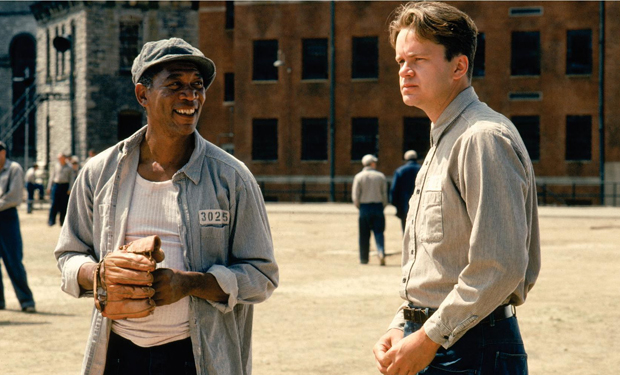The Shawshank Redemption (1994)

DIRECTOR: Frank Darabont
CAST: Tim Robbins, Morgan Freeman, Bob Gunton, Clancy Brown, Gil Bellows, James Whitmore, William Sadler, Mark Rolston
REVIEW:
Among the film adaptations of Stephen King’s written work, pickings are slim for cinematic quality. Apart from The Shining (which King himself disliked), Stand By Me, and Misery, most of the rest runs the gamut from mediocre to bottom of the barrel. The Shawshank Redemption, a product of first-time director Frank Darabont in an impressive debut and Castle Rock Pictures—the company of producer Rob Reiner, who directed Stand By Me and Misery—and an adaptation of King’s novella Rita Hayworth and the Shawshank Redemption, is a notable exception. In fact, The Shawshank Redemption is not only possibly the best film adaptation of a Stephen King work, it’s a great film period, telling a powerful and compelling story that involves wrongful imprisonment, prison abuse and corruption, but despite its grim subject matter ultimately manages to be both uplifting and cathartic.
The story spans 1947 to 1966 in the prison life of Andy Dufresne (Tim Robbins), a mild-mannered banker sentenced to two consecutive life sentences after being wrongly convicted in the murders of his unfaithful wife and her lover. Shut away within the closed-off, insular world of Shawshank Prison, Andy befriends Ellis “Red” Redding (Morgan Freeman), the self-proclaimed “Sears & Roebuck” of Shawshank who can smuggle in just about anything from the outside if the money is right. As the years tick by, Andy struggles to maintain his hope and dignity. At first, he has sexual predators to contend with, but falls under the protection of the guards when he puts his financial wizardry to work doing their taxes, and is eventually recruited to run money laundering scams for the corrupt Warden Norton (Bob Gunton). But Andy gets less cooperative when a newcomer (Gil Bellows) eventually joins the Shawshank crowd with crucial information.
Despite the vast majority of the film taking place within the unchanging walls of Shawshank, The Shawshank Redemption manages to exhibit a strong sense of time and place. Cinematographer Roger Deakins—a longtime Coen Brothers collaborator—uses muted hues and drab colors to accentuate the grim monotony of prison life, and the passage of time is marked by the changing posters on Andy’s cell wall, from Rita Hayworth to Marilyn Monroe to Raquel Welch. The slow burn pace doesn’t focus on daring prison escapes (at least for a while) or melodrama, rather giving a serious examination of the personal costs of adapting to prison life and the dangers of becoming “institutionalized” and unable to cope with freedom even if it’s eventually obtained, indelibly illustrated in a short detour following the parole of the elderly prison librarian Brooks (James Whitmore). “These walls are funny” Red grimly notes, “First you hate them, then you get used to them, then you start to depend on them”. Andy’s unflappable optimism stands as a counterargument to Red’s cynicism; the moments when he finagles a bucket of cold beers for a work detail and later barricades himself in the office blaring opera over the loudspeakers to grant both himself and his fellow inmates a fleeting mental escape are two of the film’s highlights. “Hope is a good thing”, Andy insists, “Maybe the best of things. And no good thing ever dies”.

A strong cast is another component of The Shawshank Redemption‘s success; there’s not a weak performance to be found. Tim Robbins plays the wrongfully imprisoned Andy with a stoic dignity and a sometimes inscrutable demeanor. He doesn’t rail dramatically against his fate; he plays his cards close to his chest and quietly, calmly, sets a long game in motion that we only eventually come to understand. He is solidly matched by Morgan Freeman, who plays Red with a mix of cynicism and sincerity and his customary effortless air of lived-in wisdom. Despite the character of Red being a white man in the original novella—such actors as Clint Eastwood, Paul Newman, and Robert Redford were previously considered—Frank Darabont had his eye on Freeman, and it’s hard to imagine anyone else being more at home in the part. Freeman’s running voiceover is one of the few instances in which a narration actually contributes to a film rather than distract from it. Bob Gunton as the corrupt warden, Clancy Brown as an abusive guard, William Sadler as a fellow prisoner, Mark Rolston as a rapist with an eye for Andy, and newcomer Gil Bellows (in a role originally intended for Brad Pitt) as Andy’s protege and possible ticket to freedom are all fine in supporting roles. The actor who makes the most impression, however, is one with a fairly small amount of screentime, longtime character actor James Whitmore, whose brief subplot taking one of the few detours outside the walls of Shawshank is arguably the most moving few minutes of the movie.
The Shawshank Redemption isn’t quite flawless, although it’s nearly so—the last act suddenly kicks into high gear with a climactic burst of “action” after a slow-paced previous two hours, and then settles down again for a slightly overlong final twenty minutes that take their sweet time wrapping up the epilogue—but it provides two and a half hours of involving and compelling drama that, despite being set in an environment as grim as prison, is at its core about hope, redemption, and the indomitability of the human spirit.
* * * 1/2